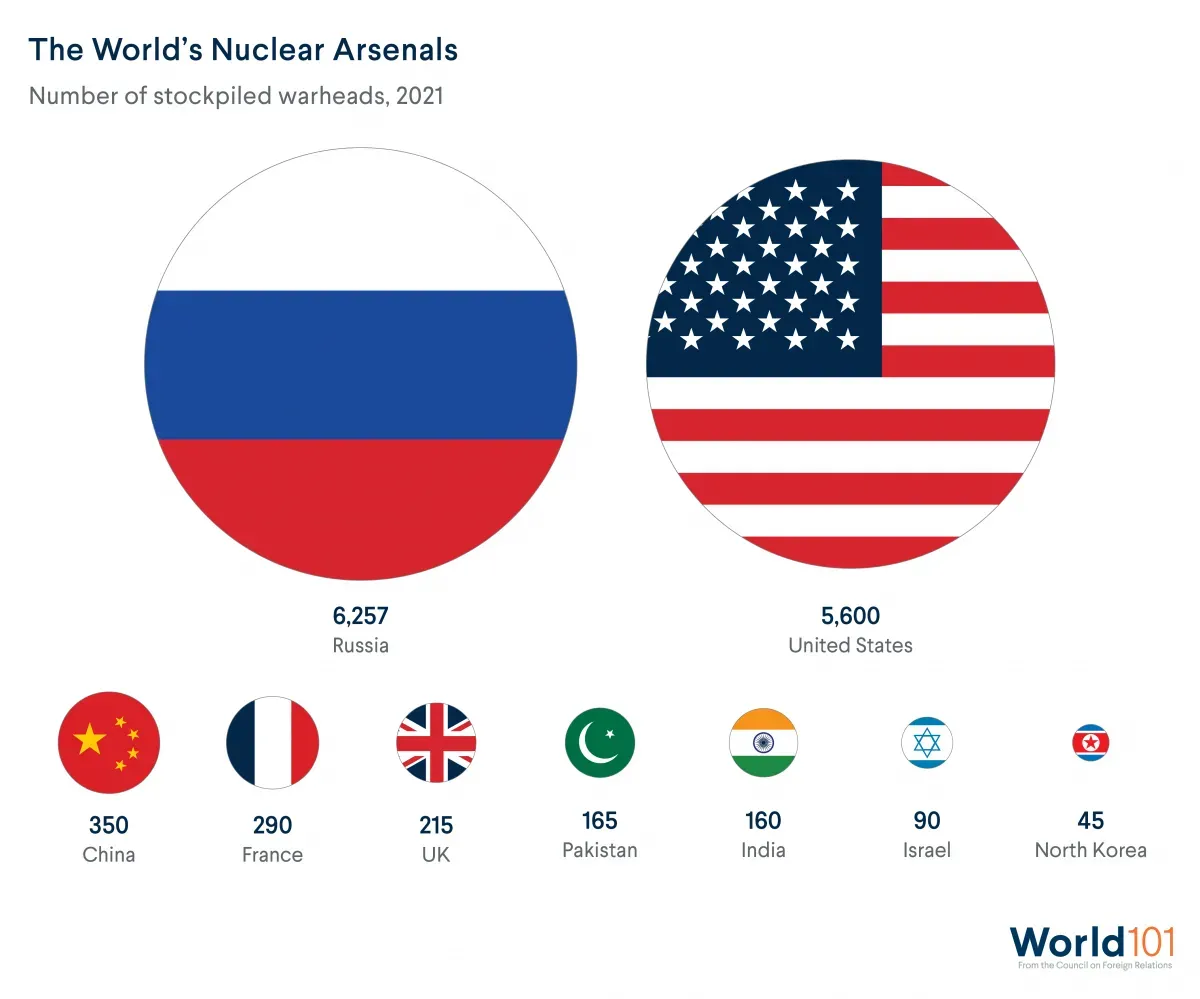What Is Deterrence?
In this free resource, explore examples of deterrence from the Cold War to present day to learn how countries dissuade bad behavior with the threat of significant punishment.
In the final years of the Cold War, the United States developed an intercontinental ballistic missile system. These long-range missiles were capable of launching ten nuclear warheads over seven thousand miles with pinpoint accuracy. The weapon’s name: Peacekeeper.
Why give one of the world’s largest and deadliest weapons such a curious title?
Irony had nothing to do with it. The United States believed that the missile’s potential for immense destruction was an avenue to peace. Intercontinental ballistic missile systems would convince the country’s rivals—namely, the Soviet Union—to avoid aggression. This tactic is known as deterrence.
In this resource, we’ll explore how countries prevent war and maintain peace with credible threats of retaliation. We’ll also weigh the limitations of this foreign policy tool.
Deterrence definition
Deterrence simply means dissuading bad behavior with the threat of significant punishment.
It’s a practice that dates back millennia and extends beyond international relations. Ancient Romans, for example, carried out public executions to discourage would-be criminals. Even today, deterrence underpins many countries’ justice systems. The threat of lengthy prison sentences—or even capital punishment—is intended to stop people from committing crimes.
In foreign policy, deterrence serves a similar purpose: maintaining peace by persuading enemies that any attack will be met with a significant response.
For deterrence to work, two conditions should be present: severity and credibility.
Severity entails threatening an opponent with retaliation that would outweigh any potential benefits they could hope to gain from attacking. A severe response can take many forms, including harsh economic sanctions, diplomatic isolation, or military action. During the Cold War, nuclear weapons served as the ultimate deterrent for the United States and the Soviet Union. Both nations built enough bombs to annihilate the other.
Credibility means making an opponent believe that their further aggression will provoke retaliation. Countries can signal their seriousness by testing weapons, increasing their military presence in a contested region, conducting exercises to simulate real attacks, and publicly announcing new weapons technologies. An important part of credibility is the willingness to use force. During the Cold War, both the United States and the Soviet Union established credibility by taking military action to support their foreign partners. These actions demonstrated that they would be able and willing to follow through on their pledges to use force if an ally were attacked. The two superpowers also built special silos, planes, and submarines to ensure that if attacked with a nuclear weapon, they could still retaliate in kind. As a result, leaders on both sides knew a strike by either country would result in both being devastated. This deterrence mechanism is an idea known as mutually assured destruction.
Safety will be the sturdy child of terror, and survival the twin brother of annihilation.
Nuclear deterrence
Although nuclear weapons have only been used twice in war since their development in 1945, countries have used the specter of nuclear weapons to advance their security far more often. The Cold War stayed largely cold because of the deterring effects of nuclear weapons. At the height of the conflict, the Soviet Union amassed forty-five thousand nuclear warheads to the United States’ thirty-one thousand.
Indeed, no two nuclear powers have ever gone to war with each other. Given this successful track record, several countries have sought to acquire nuclear weapons to secure a deterrent force of their own. North Korea, for instance, has weathered severe international sanctions to pursue its nuclear weapons program. The country’s actions have demonstrated that such a weapon serves as the ultimate security guarantee and will protect the country’s leadership from foreign intervention.
Countries approach nuclear deterrence in different ways. For example, China has pledged for decades to never launch a preemptive attack or first strike with nuclear weapons—also known as a No First Use policy. Although this pledge communicates China’s supposed intentions (the credibility of which some experts question), it says nothing of the country’s nuclear capabilities. China’s rivals continue to worry about a lack of transparency around the country’s nuclear arsenal. Meanwhile, countries like the United States, Russia, and others have refrained from adopting a No First Use position. These nations believe the legitimate threat of a nuclear first strike serves as a powerful deterrent.
To learn more about approaches to nuclear deterrence, check out “No First Use” and Nuclear Weapons.
Many countries use nuclear deterrence to ensure not only their own safety but also the security of their allies and partners. This practice is known as extended deterrence. A security guarantee provided by a nuclear-armed country is also called a nuclear umbrella. Rather than develop their own nuclear weapons, around thirty countries fall under the United States’ nuclear umbrella.
Despite the United States’ stated commitment to defending its allies, some countries under its nuclear umbrella have felt the need to pursue their own weapons programs. For example, in 1966 France’s then President Charles de Gaulle pulled the country out of the integrated military structure of the North Atlantic Treaty Organization (NATO). At the time, France preferred to maintain its own nuclear deterrent rather than rely on the United States for protection.
No punishment has ever possessed enough power of deterrence to prevent the commission of crimes.
The limitations of deterrence
Many experts believe that deterrence, when used effectively, serves as a powerful tool for maintaining peace. However, threatening severe retaliation can also carry significant consequences.
Security dilemma
Nuclear deterrence can lead other countries to develop their own weapons programs. Ongoing nuclear proliferation only raises the stakes of any potential conflict. For instance, Saudi Arabia has pledged to acquire nuclear weapons if Iran—its fierce rival—does so first. If more countries develop their own nuclear weapons—what is known as nuclear proliferation—then nuclear weapons use becomes more likely. The risk of a miscommunication between nuclear powers also becomes more dangerous. During the Cold War, for instance, NATO conducted an annual simulation of a nuclear threat called the Able Archer exercise. In 1983, however, NATO implemented new measures, including using dummy warheads and different coded communications. Fearful the exercise was in fact a smoke screen, the Soviets readied their own nuclear forces for war. The crisis was ultimately averted. However, the two sides came perilously close to bombing each other over a misunderstanding.
Costs of credibility
Governments lose credibility when they fail to back up their threats. The United States, for instance, stated in 2012 that Syria’s use of chemical weapons would cross a “red line.” However, the Obama administration subsequently refused to intervene when the Syrian government gassed hundreds of its civilians in 2013. This failure to act cost the United States credibility with its allies and foes alike. Alternatively, following through on one’s threats can also carry serious repercussions. Prior to World War I, European leaders had spent years constructing a network of alliances. In theory, those alliances were intended to deter conflict. In reality, the alliance networks had the opposite effect of expanding a local issue—the assassination of Austrian Archduke Franz Ferdinand—into a continent-spanning crisis. The complex alliance networks in Europe required countries to follow through on their alliance pledges and march to war.
Assumptions of rationality
Deterrence theory assumes that actors prioritize their well-being: the United States did not bomb the Soviet Union because doing so would have resulted in its own destruction. However, not everyone is rational. Leaders have many times sent their citizens into war despite strong deterrents and obvious consequences. Similarly, many experts fear that a rogue actor will not always make rational decisions with their power. An erratic or irrational leader in control of nuclear weapons could lead to catastrophe. Additionally, terrorism is notoriously difficult to deter,as the threat of death carries little weight. Individuals committed to a terrorist organization may be already willing to carry out suicide attacks.
Minimal safeguards
In the United States, the president is expected to consult with advisors before authorizing a nuclear strike. However, the former head of U.S. Strategic Command left open the possibility during a 2017 hearing that, if determined, a president could potentially order a first-use nuclear launch single-handedly. The hearing revealed that the president is faced with few—if any—constraints to their nuclear authority. To avoid a rash and imprudent nuclear strike, some experts have called for additional checks and verifications to be added to the approval process for first-use nuclear strikes.
Proving a counterfactual
An enemy attacking is a clear sign that deterrence has failed. However, proving deterrence has worked is tricky. If an enemy doesn’t attack, they could have been sufficiently deterred or simply never intended to attack in the first place. For example, it’s impossible to know what would have happened in the Cold War if neither side had had access to nuclear weapons or practiced such high-stakes deterrence.
Deterrence serves as a cornerstone of many countries’ foreign policy strategies. When used wisely and in coordination with other foreign policy tools, deterrence can help maintain peace and prevent war. But when deterrence fails, the consequences can be calamitous.
Now that this resource has covered the fundamentals of deterrence, put those principles into practice with CFR Education's companion mini simulation on Deterrence.





